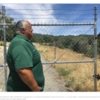Eric Ortega walked through Warner Springs on a recent hot afternoon.
“I see our homeland,” he said, looking at houses that dot vast rolling expanses of land covered by dry brush and trees.
“My grandmother lived in one of those houses,” said the 54-year-old Ortega. “My grandfather lived in those houses."
And just east of the homes, sit two large pools of water sprung from the ground. One hot. One cool.
Ortega said practicality and spirituality drew his ancestors to the springs possibly as far back as 4,000 years ago.
“The claims that were made in the 19th century was that these hot mineral waters could cure just about anything, I mean cancer, tuberculosis, all kinds of diseases,” said Phil Brigandi, a local historian. “The hot springs were of course good for some joint-type diseases because they were warm and soothing.”
“Eventually, the folks who own the Warner Ranch, led primarily by a man named John Downey who was a former governor of California, decided they wanted access,” Brigandi said, “… so they instituted a lawsuit treating the Indians as if they were trespassers.”
The lawsuit prevailed. In 1903, the Cupa Indians were removed
Some 200 men, women and children were marched on a three-day, 60 mile journey to the Pala reservation.
“The eviction of 1903 was the trail of tears for the Cupeño people and the other Indian people living on the Warner Ranch,” Brigandi said. “They wanted to live where they had always lived. They lived in good substantial adobe homes by the springs. Their church was there. They had a government, a school there, their graveyard with the bones of their ancestors was there."
To read more of Amita Sharma's article, please click here.



Comments (0)